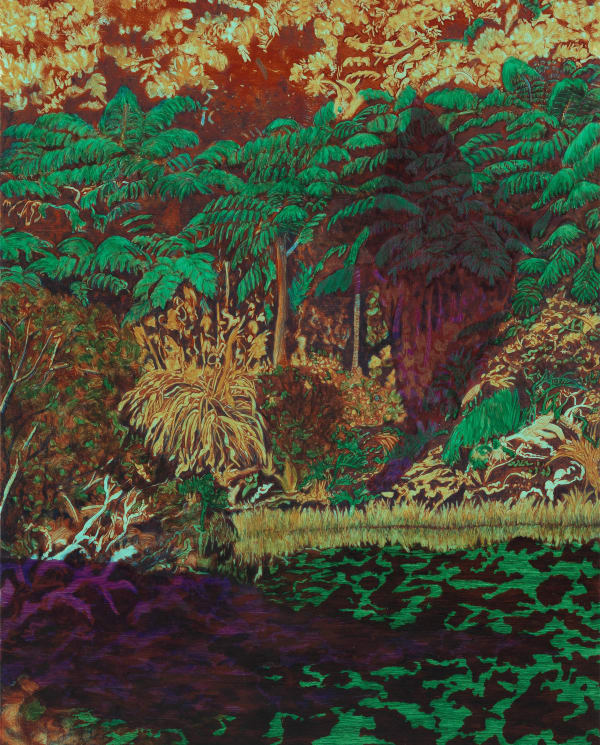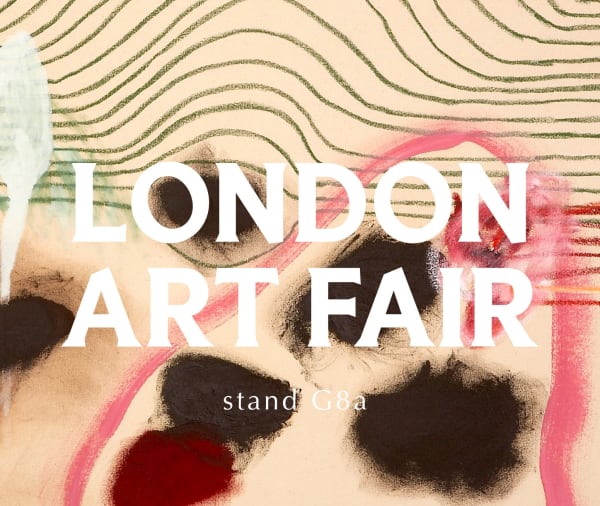Robyn Litchfield
Landscape becomes a ubiquitous template for exploring personal history, notions of cultural identity, alienation and a sense of belonging. Wilderness is used as the transitional liminal space, which can be seen as a place of disorientation and dissolution of order
Drawing from archival photographs and personal documents relating to the early exploration and colonisation of New Zealand, Robyn Litchfield reimagines and examines the experience of those early forays into a hitherto unknown space. Her paintings envisage how sublime encounters with places; pristine and untouched might encourage contemplation and self-reflexivity.
Landscape becomes a ubiquitous template for exploring personal history, notions of cultural identity, alienation and a sense of belonging. Wilderness is used as the transitional liminal space, which can be seen as a place of disorientation and dissolution of order. Processes such as scraping into the paint, layering and erasure reference the destructive and constructive nature of being in a state of liminality. This space can offer an opportunity for reconfiguring subjectivity and a reimagining of possibilities.
An alluring luminosity projects through the monochrome images of dense forest. Elements extracted from the documents of primeval landscapes intrude into the space. For Litchfield they are haunting symbols of loss and longing; for past lives left behind, the dispossessed and the primeval forest. This layer of amorphous red shapes acts like a semiotic screen casting its shadow on the gaze. Through the uncanny layering and the juxtaposition of images, the viewer is encouraged to form their own associations and interpretations of the work whilst engaging with the otherness of landscape through paint.
-
 Beckoning, 2023Robyn Litchfield, Beckoning, 2023£ 4,500.00
Beckoning, 2023Robyn Litchfield, Beckoning, 2023£ 4,500.00 -
 Dearly Departed, 2023Robyn Litchfield, Dearly Departed, 2023£ 1,200.00
Dearly Departed, 2023Robyn Litchfield, Dearly Departed, 2023£ 1,200.00 -
 Do Nothing But Listen, 2023
Do Nothing But Listen, 2023 -
 Enclosed Within Its Shadow, 2023Robyn Litchfield, Enclosed Within Its Shadow, 2023£ 10,500.00
Enclosed Within Its Shadow, 2023Robyn Litchfield, Enclosed Within Its Shadow, 2023£ 10,500.00 -
 Fragment 2, 2023Robyn Litchfield, Fragment 2, 2023£ 2,200.00
Fragment 2, 2023Robyn Litchfield, Fragment 2, 2023£ 2,200.00 -
 Fragment I, 2023Robyn Litchfield, Fragment I, 2023£ 2,200.00
Fragment I, 2023Robyn Litchfield, Fragment I, 2023£ 2,200.00 -
 Fragments Of Longing, 2023Robyn Litchfield, Fragments Of Longing, 2023£ 4,200.00
Fragments Of Longing, 2023Robyn Litchfield, Fragments Of Longing, 2023£ 4,200.00 -
 Precious Grove, 2023
Precious Grove, 2023 -
 Sentinel, 2023
Sentinel, 2023 -
 Spectral Lure, 2023Robyn Litchfield, Spectral Lure, 2023£ 7,000.00
Spectral Lure, 2023Robyn Litchfield, Spectral Lure, 2023£ 7,000.00 -
 The Earth Sweated With Primeval Sleep, 2023Robyn Litchfield, The Earth Sweated With Primeval Sleep, 2023£ 4,500.00
The Earth Sweated With Primeval Sleep, 2023Robyn Litchfield, The Earth Sweated With Primeval Sleep, 2023£ 4,500.00 -
 Time's Torrent Bed, 2022Robyn Litchfield, Time's Torrent Bed, 2022£ 10,000.00
Time's Torrent Bed, 2022Robyn Litchfield, Time's Torrent Bed, 2022£ 10,000.00 -
 Wanganui River, 2022Robyn Litchfield, Wanganui River, 2022£ 3,800.00
Wanganui River, 2022Robyn Litchfield, Wanganui River, 2022£ 3,800.00 -
 Forest Portal Expanded (framed), 2022Robyn Litchfield, Forest Portal Expanded (framed), 2022£ 980.00
Forest Portal Expanded (framed), 2022Robyn Litchfield, Forest Portal Expanded (framed), 2022£ 980.00 -
 Forest Portal Expanded (unframed), 2022Robyn Litchfield, Forest Portal Expanded (unframed), 2022£ 630.00
Forest Portal Expanded (unframed), 2022Robyn Litchfield, Forest Portal Expanded (unframed), 2022£ 630.00 -
 Forest Portal, 2022Robyn Litchfield, Forest Portal, 2022£ 320.00
Forest Portal, 2022Robyn Litchfield, Forest Portal, 2022£ 320.00 -
 Tai PoutiniRobyn Litchfield, Tai Poutini£ 175.00
Tai PoutiniRobyn Litchfield, Tai Poutini£ 175.00 -
 Wilmott Pass, 2021
Wilmott Pass, 2021 -
 The Hollow Place
The Hollow Place -
 Forest Margin, 2020
Forest Margin, 2020
-

Let Time Be Still
Robyn Litchfield 21 Jun - 6 Aug 2023Starting at The Fitzrovia Gallery in London (21 - 25 June) before continuing on to Darl-e and the Bear in Woodstock (1 - 23 July), Robyn Litchfield explores representations of sublime encounters with pristine and untouched landscapes through a series of new paintings in her first solo exhibition.Read more -

Spring Exhibition
A collection of gallery artists 13 Apr - 15 May 2023This exhibition features prints, paintings and ceramics by established and emerging artists from across the UK.Read more -

London Art Fair
17 - 22 Jan 2023Darl-e and the Bear presents Miranda Boulton, Sandra Beccarelli, Justine Formentelli, Fi Hunter, Robyn Litchfield and Mandy Payne for the 2023 London Art Fair, 17 - 22 January 2023Read more
























